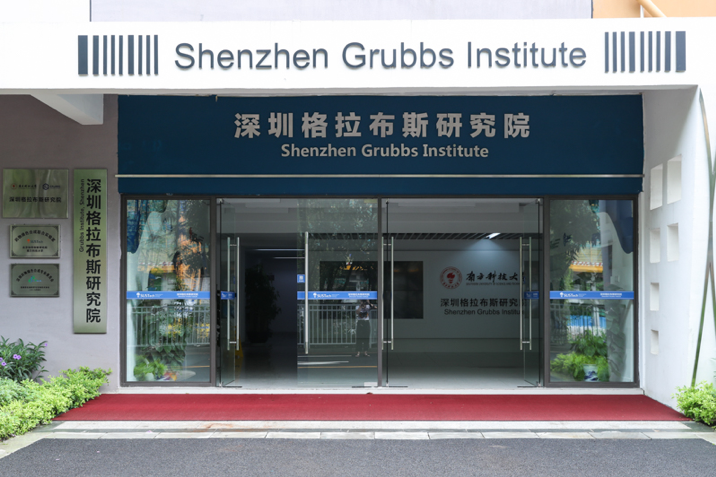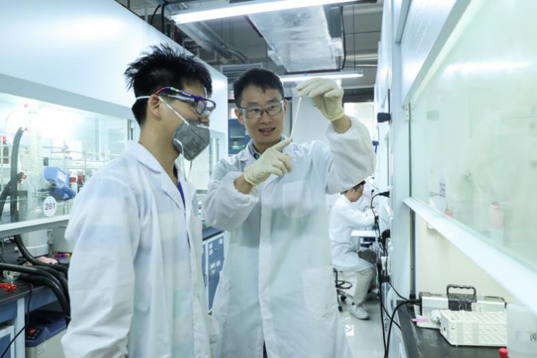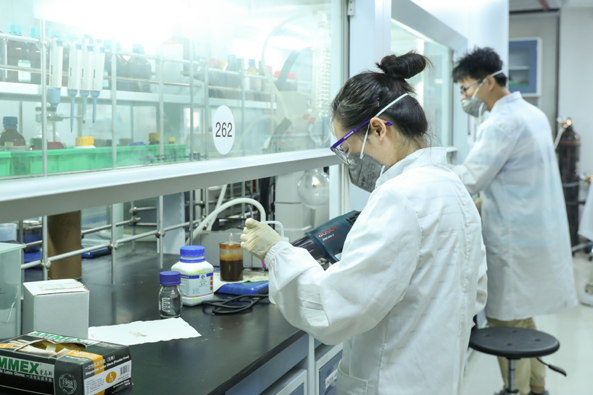
The Shenzhen Grubbs Institute was established on October 12, 2016, by Shenzhen Municipal Government and named after Nobel laureate Robert H. Grubbs. It was officially unveiled and launched on the campus of Southern University of Science and Technology (SUSTech) in May 2017. March 2018 saw the first Executive Dean, Professor Zheng Zhiping, take office. Prof. Zheng, as the recipient of the national 1000-Talents program, is also the Head of the Chemistry Department at SUSTech.
So what has been achieved by the Institute so far? The Newshub interviewed Prof. Zheng Zhiping.
On August 17, 2018, Dr. C. Daniel Mote, the President of the National Academy of Engineering (NAE), led a group of the NAE members to Shenzhen, to visit the Shenzhen Grubbs Institute, accompanied by Prof. Robert H. Grubbs, the Institute’s Honorary Dean.
Dr. C. Daniel Mote and the delegation spoke highly of the Shenzhen Grubbs Institute and believed that the Institute would bring new opportunities to the development of related fields.
The Shenzhen Grubbs Institute is committed to make breakthroughs in basic research and put its scientific achievements and knowledge to use. Prof. Robert H. Grubbs, the Institute Honorary Dean, has achieved a series of scientific success. In addition to his world-renowned achievements in basic research, a catalyst, called Grubbs catalyst, named after him, have been widely used in medicine, materials, energy, and the chemical industries.
He used his catalyst as the core platform technology and created many high-tech enterprises. His enterprises covered industries such as new materials, clean energy, medical materials, and green chemicals. Grubbs’ scientific achievements and influence, together with his talented team and the scientific research infrastructure of SUSTech, enabled the development of the Institute.
As an important member of the “Top Ten Action Plan” that has been vigorously promoted by the city of Shenzhen, the Shenzhen Municipal Government has also given plenty of support to the Institute. Progress is being made on the construction of a permanent home for the Institute, along with creating a team of high-level talents and the creation of high-level instrument platforms. The Institute is also working on developing top international cooperation and exchanges, as part of its commitment to making original and revolutionary innovations in basic research.

Scholars Pooled in for Research
The top priority of scientific research is putting together a team of talents. According to Executive Dean Zheng Zhiping, the talents of the Institute are mainly divided into two categories. One is the team of research faculty members from SUSTech, mainly composed of faculty members, part-time professors, and research professors. The other category of talent is represented by the international research team, and the members come from MIT, Stanford, Caltech, Berkeley College (UC Berkeley), University of Chicago and UCLA. Members of the international team will participate in the Institute as the visiting scholar or getting funding from the foreign 1000-Talents Program. They participate in the research Institutes through international cooperation and participate in research Institutes through different forms of cooperation. As a result, the international research team is bringing excellent scientific ideas and thinking into the research Institutes.
The Shenzhen Grubbs Institute has a two-way selection mechanism and a dynamic flow mechanism to build a team of researchers. If an academic’s research is related to the Institute’s research field, the researchers can apply to join the Institute if they are willing to do so. The Institute also gives understanding and permission to the researchers whose research content deviates from the Institute’s research field, under the consideration of the Academic Committee. Zheng Zhiping said that Grubbs doctoral student Chen Zhongren is one of the top talents attracted to the Shenzhen Grubbs Institute. On the basis of developing the theory of failure mechanisms and crack propagation of soft materials, he presided over the industrial synthesis and application of a new generation of high-performance rubber materials, which produced huge economic and social benefits.
At present, the Institute has part-time academicians such as Professor Chi-Ming Che, Professor Tang Yong, and Professor Liu Ke. They also have distinguished faculty members like Professor of Chemistry Liu Xinyuan, National Science Fund for Distinguished Young Scholar Professor Tan Bin and National Outstanding Youth Science Foundation Associate Professor of Chemistry He Chuan, who has just joined SUSTech since returning from Cambridge University this year.The range of ages in the Institute provides a strong guarantee for the long-term development of scientific research.
In addition, doctoral students, master’s students, and even undergraduates at SUSTech can participate in laboratory research at the Institute.
Grubbs conducts and directs research work in Shenzhen for a month every year. The “brand effect” of Nobel Laureates results in a pooling of talent, seeing more outstanding researchers wanting to join the Institute. Every year, the Institute conducts academic exchanges at home and abroad and holds the Grubbs Forum. The increased interactions with outstanding scholars at home and abroad have resulted in more sparks and more interdisciplinary thinking.
Steady Progress Made Following Achievement of Initial Results
At present, for the research progress of the Institute, Prof. Zheng Zhiping said that the Institute was just starting, focusing on the stage of scientific research accumulation. The Institute is concentrating its efforts on scientific research, and then moving towards the patent application stage. After the basic research work is properly done, through the university-industry collaboration, it will promote the outstanding achievements to the society and contribute to social development.
Although, the equipment of the Institute is still not perfect, the scientific research work has not stopped. The Institute and the Department of Chemistry are both independent of each other administratively and financially, researchers and equipment from both sides are closely intertwined. The sharing of resources made the Institute start very quickly, and research work has been carried out smoothly since its inception. The Institute’s research equipment is being perfected, and more than a dozen laboratories are already making full use of the current conditions. The high-throughput screening equipment and supporting facilities of the core equipment purchased by the Institute from the United States will soon arrive at the Institute. The NMR instrument and analytical liquid phase of the laboratory are now available. Equipment such as high performance liquid chromatography (HPLC), gas chromatography (GC), and super-critical liquid chromatography (SFC) is all in operation.
The Institute has achieved a lot of achievements in its infancy and has published dozens of high-level papers in internationally renowned journals such as Angew. Chem. Int. Ed. Professor Tan Bin’s paper (research work) is going to publish in (be published on) “Science.”
Prof.Zheng Zhiping is also the recipient of the national 1000-talents program. He currently focuses on “hydrogenation of methanol and water to produce hydrogen” and “water decomposition into hydrogen and oxygen” experiments. In theory, the seemingly viable chemical reactions are difficult to operate in practice. The key points of this experiment are how to find or create the appropriate catalysts, and how to promote them. These two studies are of great significance for creating clean energy and protecting the environment.
Professor He Chuan, who just came to SUSTech in March this year, said, “A lot of equipment was not available when I first came here. Now I can experiment in a large laboratory.” Professor He Chuan, who is currently studying the functionalization and electrochemical synthesis of carbon-hydrogen bonds, points to an electrochemical synthesizer and says, “This can also be connected to a mobile phone, manipulated by a mobile phone, and chemically decomposed by electricity, which is much more convenient and safer. The laboratory will purchase a few.” Researchers are basically in the lab for six days a week, from 9 am to 10 pm, with great motivation.

Steady Progress to Build an Influential Research Platform in the World
The Shenzhen Grubbs Institute takes small molecular catalysis and macromolecular materials as its two main research fields. It is mainly involved in the fields of new medicine and new materials. Among them, the new pharmaceutical field focuses on building a green pharmaceutical synthesis platform, concentrating on the high-efficiency synthesis of major drugs, the precise synthesis of hepatitis C drugs, and the efficient synthesis of new drug molecules. The new material field focuses on building functional polymer platforms, centering on the direction of ultra-strong fiber and biomedical equipment, high-performance wind blade manufacturing, high-performance anti-corrosion, and bulletproof materials, and advanced super-hard and ultra-strong materials.
At present, the Institute is working in accordance with its sub-goals, focusing on its current work as the main focus, and cultivating the best environment for scientific research.
“The future world and scientific research forms are changing rapidly, and no one can accurately predict them,” said Prof. Zheng. Looking at the future targets, he is more down-to-earth.
According to his planning, it is a five-year foundation to build the Institute and its talent team as well as complete its basic work. In the second five years, under the ideal conditions, the Institute will expand its scale and infrastructure and recruit more scholars. With a larger scale, more infrastructure and more talents, the Institute would be able to focus on the results of the first five years and study in a deeper direction, accelerate the transformation of production, learning, and research under SUSTech’s support of the university-industry collaboration.
In the future, he expects to concentrate on making the Institute an influential international and open research platform in the world. On this basis, we should move toward a higher goal. That higher (final) goal is to become a national key research base for developing new medicine and materials, also as a world-class research center open to the researchers globally.
Proofread ByXia Yingying
Photo ByZhang Xiaoyan